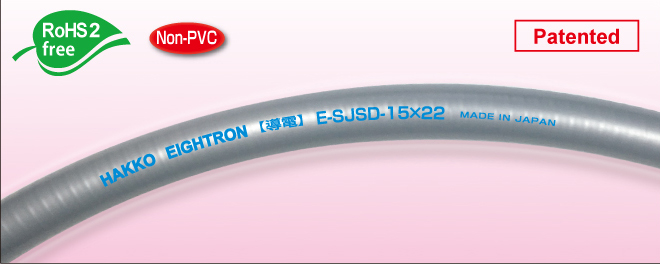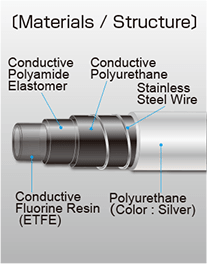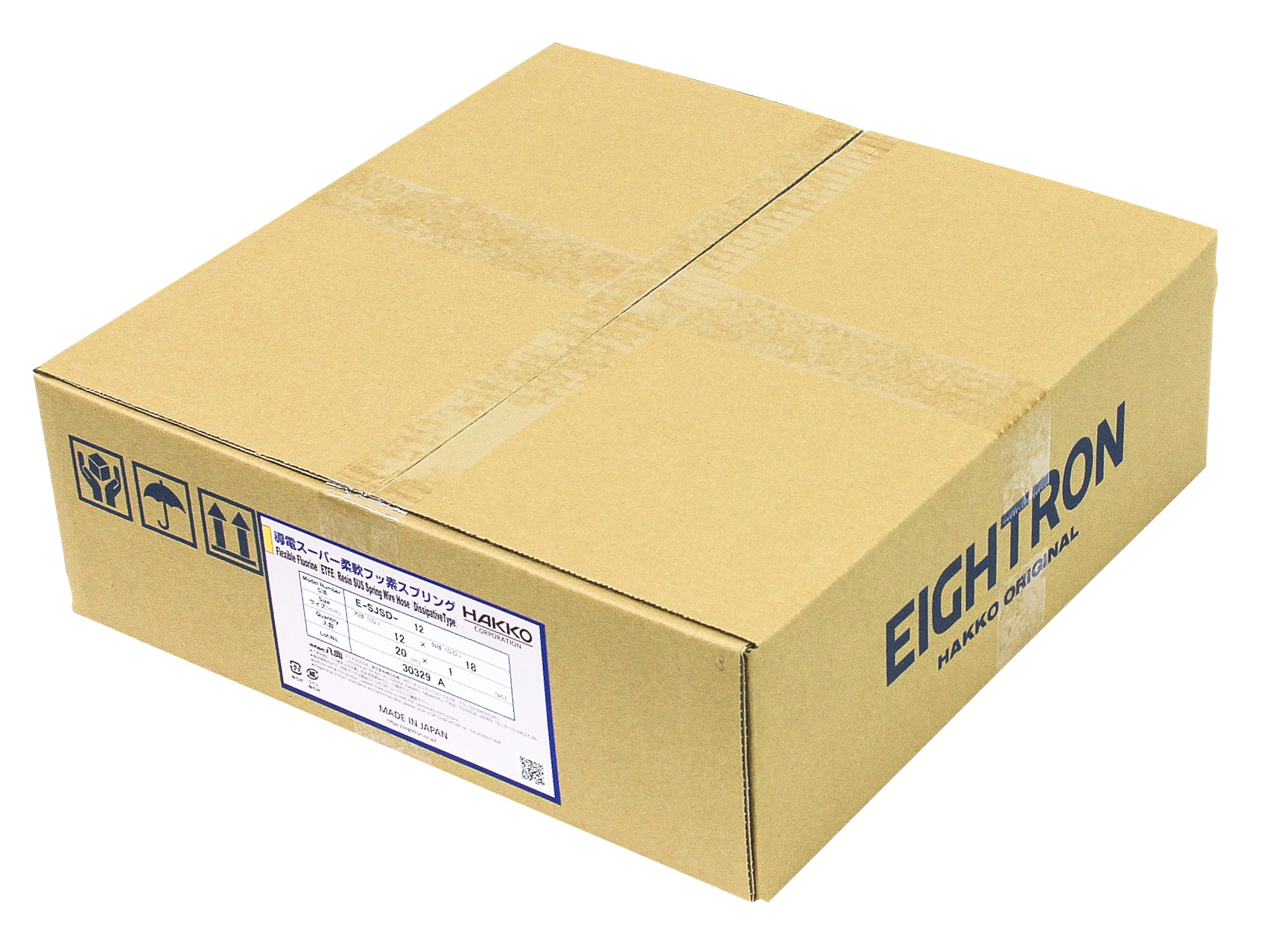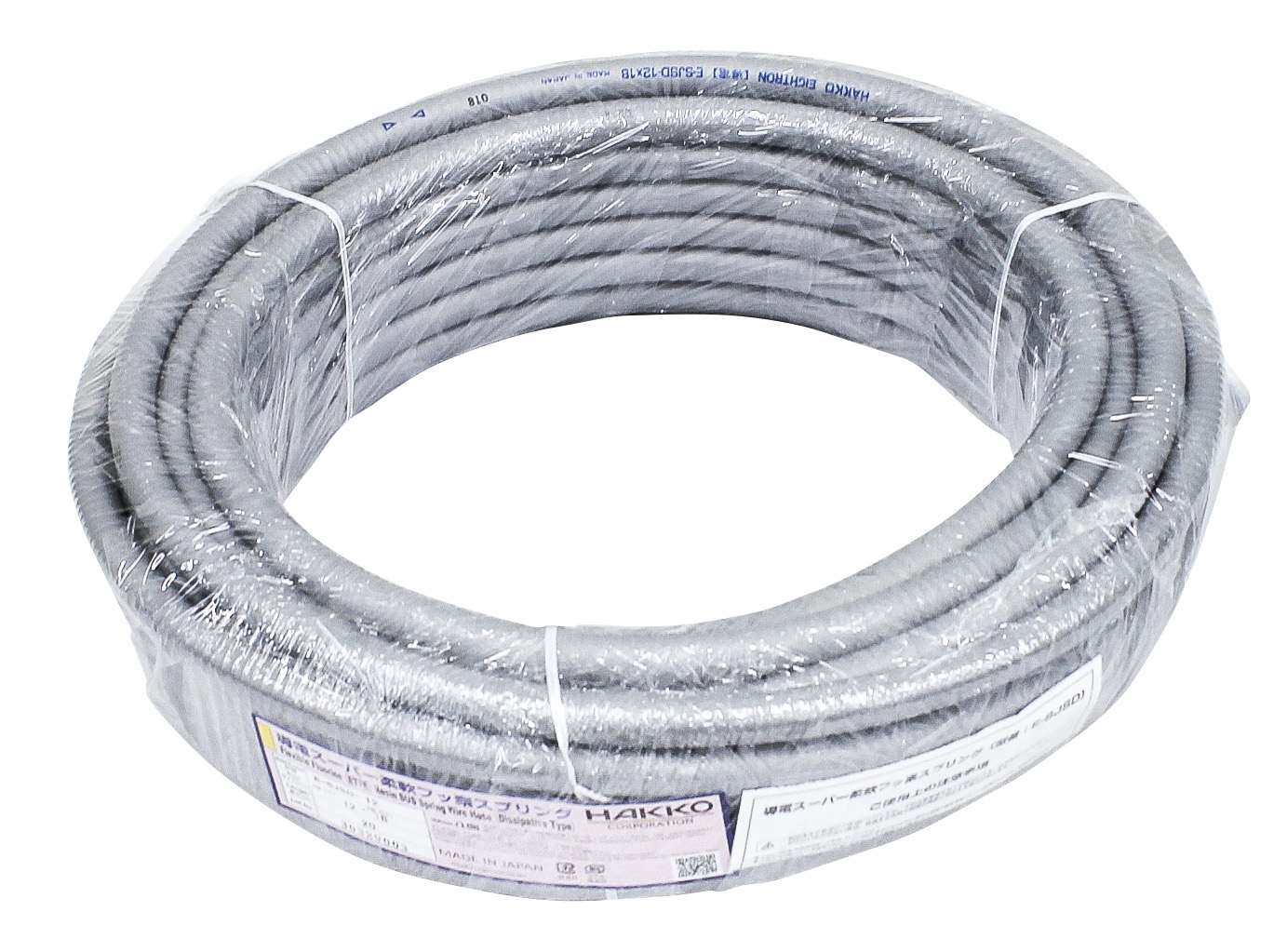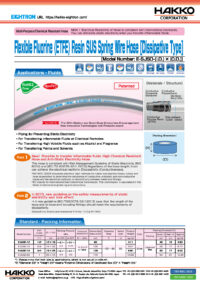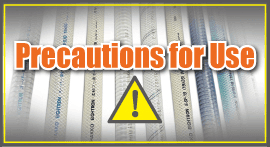Flexible Fluorine (ETFE) Resin SUS Spring Wire Hose (Dissipative Type) [Model Number: E-SJSD]
Multi-Purpose / Chemical Resistance Hose | Electrical Resistivity of Hose is compliant with international standards. The static electricity is less likely to be charged even though highly flammable fluids are transferred.
Fluids
 chemicals
chemicals ink
ink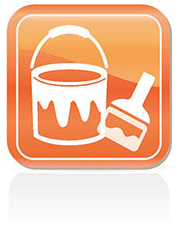 paint
paint flux
flux UVpaint
UVpaint UVink
UVink food
food drink
drink powder
powder inflammable
inflammable Applications
- Piping for Preventing Static Electricity
- For Transferring Flammable Fluids at Chemical Factories
- For Transferring High Volatile Fluids such as Alcohol and Fragrance
- For Transferring Paints and Solvents
Functions
Conductive
Solvent Resistance
Non-PVC
Non-Adhesiveness
Chemical Resistance
Low Odor
Food-Sanitation
UV Cut
Vacuum
Oil-Proof
Hard to Break
Alcohol Resistance
UL Compliant
Characteristics
- Chemical Resistance...Since the inner layer is made of ETFE Fluorine Resin, E-SJSD stands proof against most of the chemical substances.
- Dissipative...Due to the use of conductive resin and metal fiber, no matter how long a hose is, electrical resistivity (Conductive: Dissipative Grade) is achieved.
- Compliance with Guideline...The value of electrical resistivity is compliant with ISO 8031 and IEC/TS 60079-32-1: 2013 (Explosive Atmosphere: Part 32-1: Guideline for Dangerous Static Electricity).
- Higher Non-Adhesiveness...Since ETFE fluorine resin is superior in terms of non-adhesiveness, you can wash out the fluids very easily.
- Vacuum...E-SJSD can be used in vacuum conditions, keeping high stability in its shape.
- Plasticizer-Free...E-SJSD does not contain plasticizer (an elution material) at all. E-SJSD is an oil-free hose.
- UV Cut...E-SJSD can shield the ultraviolet (Wavelength: from 240nm to 800nm) over 99%.
- Original Fittings...By using our original fittings, you can avoid accidents which are caused by incorrect choices of hose and fittings. For more information on our original fittings, please scroll down to the end.
Certificates and Regulations
- RoHS Compliant...E-SJSD is compliant with RoHS requirements (Directive: (EU) 2015/863). (RoHS Compliant means that E-SJSD does not contain RoHS 10 restricted substances or it does not exceed the upper threshold of RoHS 10 restricted substances.) Certificate is available on request.
- UL94HB Equivalent...According to the third-party institution test, E-SJSD is confirmed as equivalent to UL94HB (Flame Retardancy Test UL94HB Horizontal Combustion Test). Certificate is available on this webpage.
- Non-Use of UV-328...E-SJSD does not contain UV-328. Certificate is available on request.
- Food Sanitation...E-SJSD conforms to the Food Sanitation Law No.380 (No.380 of the Ministry of Health and Welfare for Food Sanitation) (Conformity to N-Heptane) and the Partial Revision of Standards for Food and Additives (Positive List System) [No.324 of the Ministry of Health, Labour, and Welfare]. Regarding the conformity of “Partial Revision of the Food Sanitation Law” (Effective on June 1, 2020) and Positive List System (PL), please download here.
Packing Images
Product Standard
- Temperature Range : -20 - 80 $^\circ$C (-4$^\circ$F - 176$^\circ$F)
- Color : Silver
Leaflet Request
For more information on our Product Standard of E-SJSD, please click "Product Leaflet Download" above.
Specification Request
For more technical information (such as Thickness of Each Layer and Precautions in Use) on E-SJSD, please click "Product Specification Download" above.

Cautions:
- Please do not use the joints to seal an outer surface of the hose. This may result in the bursting or coming off from the hose. Please do not use plastic fittings.
- When you use our products, please refer to "Precautions for Use." ("The Precautions for Use" of E-SJSD is also downloadable here.)
- In terms of chemical resistance, please refer to "Chemical Resistance Data."
- The outer layer of E-SJSD is made of polyurethane. Please keep in mind that the outer layer of E-SJSD does not have any resistance against chemicals and solvents.
- Although the inner layer is made of ETFE fluorine, please make sure whether or not E-SJSD is usable for high purity fluids before you use.
- Although the inner layer is resistant to fluids, depending on working environments, the fluids would be permeated through the inner layer, resulting in the danger of swelling and degradation of the middle or outer layer.
- Flexible Fluorine (ETFE) Resin SUS Spring Wire Hose (Dissipative Type) does not have the function of getting rid of already charged fluids. Please take another approach to deal with.
- Regarding the original fittings for Flexible Fluorine (ETFE) Resin SUS Spring Wire Hose (Dissipative Type) [E-SJSD], if the hose is NOT used in the fixed pipe, we recommend you to choose E-ELS-GN: EIGHTLOCK S Fittings (with Hose Guide).
- Since "Flexible Fluorine (ETFE) Resin SUS Spring Wire Hose (Dissipative Type)" contains carbon, its durability against repeated bending stress is inferior to that of the "Flexible Fluorine Resin Hose Series." Depending on the conditions of repeated bending, it may cause cracking. Thus, we kindly request customers to verify the product about whether or not it can be used.
Case Study
Problem: Inadequate Measures against Static Electricity: A Story from Regular Audit
Company A has been using a Teflon hose. However, the recent audit pointed out that the Teflon hose does not have any measurements against the static electricity. Thus, Company A now has to look for an alternative hose that can stand against solvents.
HAKKO Solution:
HAKKO proposed E-SJSD: Flexible Fluorine (ETFE) Resin SUS Spring Wire Hose (Dissipative Type) and provided a sample. An inner layer of E-SJSD is made of conductive ETFE fluorine. A middle layer is made of conductive polyurethane with stainless steel wire. The inner layer shows higher levels of solvent resistance. Also, E-SJSD is a perfect hose composition to deal with the static electricity. As a result, after Company A evaluates E-SJSD, Company A is satisfied with the solvent resistance and anti-static levels of E-SJSD.
Frequently Asked Question
Question: What is the characteristic of E-SJSD?
Answer: E-SJSD meets the international guideline on static electricity. With special structures of the hose, E-SJSD prevents the generation of static electricity, resulting in the creation of safe work environment. If you transport a high flammable fluid, we strongly recommend you to consider E-SJSD.
Question: What does "Dissipative" mean?
Answer: "Dissipative" is one of the classifications of surface resistivity. In terms of electrical resistivity, "Conductive" is defined as 10³~10⁵Ω-m, "Dissipative" is defined as 10⁶~10⁸Ω-m and "Anti-Static" is defined as 10⁹~10¹³Ω-m. For the purpose of suppressing the levels of static electricity, it is said that "Conductive" comes first, "Dissipative" comes next, and "Anti-Static" comes last.
Technical Information
(A) Relationship Graph between Working Temperature and Maximum Working Pressure
(B) Resistance Value by Hose Length
Measurement method: HAKKO original fittings are attached to both ends, and the resistance value between the fittings is measured by an insulation resistance meter. (However, in order to accurately measure the resistance value for a product with conductive line layers, please do not attach the lead rods on the line layer.)
Notes: The data above are the test values and are not guaranteed values.
Electrical Properties of Major Flammable Fluids (Conductivity)
The following information is cited from "Industrial Safety and Health Research Institute Technical Guidance on Electrostatic Safety Guide 2007 ISSN 1882 -2703 JNIOSH-TR-NO. 42 (2007) page 157 - 162 G.5."
Insulating Fluid (<100 pS/m)
HAKKO Original Fittings for E-SJSD
| Product Name | Materials, Characteristics |
| EIGHTLOCK S Fittings (with Hose Guide) [Model Number: E-ELS-GN]] |
- Material: SUS304 (SS304) (Body, Ring, Nut), POM (Sleeve)
- Our Nut Type Original Made-in-Japan Fittings with Hose Guide
- Since the inner layer of the fitting is flat and does not use the rubber packing, fluid accumulation is unlikely to occur. Thus, it is easy to wash out.
- Since you do not need hose clamp and the controlling torque value, you can standardize how to install the fitting.
|

|
| EIGHTLOCK S Fittings [Model Number: E-ELS]] |
- Material: SUS304 (SS304) (Body, Ring, Nut), POM (Sleeve)
- Our Nut Type Original Made-in-Japan Fittings
- Since the inner layer of the fitting is flat and does not use the rubber packing, fluid accumulation is unlikely to occur. Thus, it is easy to wash out.
- Since you do not need hose clamp and the controlling torque value, you can standardize how to install the fitting.
|
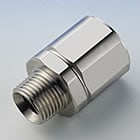
|
| EIGHTLOCK B Fittings [Model Number: E-ELB]] |
- Material: BSBM (Body, Ring, Nut), POM (Sleeve)
- Our Nut Type Original Made-in-Japan Fittings
- Since the inner layer of the fitting is flat and does not use the rubber packing, fluid accumulation is unlikely to occur. Thus, it is easy to wash out.
- Since you do not need hose clamp and the controlling torque value, you can standardize how to install the fitting.
|
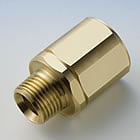
|
| EIGHTLOCK Ferrule Fittings [Model Number: E-ELF]] |
- Material: Body: SCS16, Nut and Ring: SCS13 (Sleeve: POM)
- You can replace a hose even though the hose needs replacement, since EIGHTLOCK Ferrule Fitting is a nut ferrule fitting. You can install and detach the fitting on site.
- You can make use of a wide range of usages such as pipes for chemicals, food, beverage and alcohol.
- The nipple end is less likely to accumulate fluids, so you do not have to worry about contamination very much.
|

|
| EIGHTLOCK Ferrule Fittings with PFA Lining [Numéro de Modèle: E-ELF-PFA]] |
- Matériau: Corps: SCS16, Partie en contact avec le fluide : Revêtement PFA, écrou et bague : SCS13 (manchon : POM)
- Grâce au revêtement en PFA, vous pouvez transférer des fluides qui ne sont pas possibles avec des raccords métalliques.
- Vous pouvez remplacer un tuyau même si le tuyau a besoin d'être remplacé, car le raccord EIGHTLOCK est un raccord à bague à écrou. Vous pouvez installer et démonter le raccord sur place.
- Vous pouvez utiliser une large gamme d'usages tels que les tuyaux pour les produits chimiques, les aliments, les boissons et l'alcool.
- L'extrémité de la tétine est moins susceptible d'accumuler des liquides, de sorte que vous n'avez pas à vous soucier beaucoup de la contamination.
|
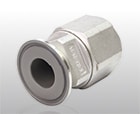
|
| EIGHTNIPPLE S Fittings [Model Number: E-FTS]] |
- Material: SUS316L (SS316L)
- SUS316L (SS316L) is superior in corrosion resistance, so you can transfer a wide range of fluids.
- Two-stage flat nipple structure which maximizes hose pressure
- Our Original Barb Nipple Fittings
- Made-in-Japan Fittings
|
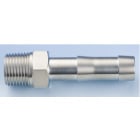
|
| EIGHTNIPPLE B Fittings [Model Number: E-FTB]] |
- Material: BSBM (Brass)
- Compliant with RoHS2 requirement
- Two-stage flat nipple structure which maximizes hose pressure
- Our Original Barb Nipple Fittings
- Made-in-Japan Fittings
|

|
HAKKO Original Accessory for E-SJSD
| Product Name | Materials, Characteristics |
| Protective Spring Guards [Model Number: E-HSL]] |
- Material: SUS304 (Band, Spring and Fastener)
- Spring guards prevent kinking, so you can transfer fluids safely.
- E-HSL prevents kinking even if the bending radius is small due to the space-saving piping.
- When you install E-HSL on the fitting, E-HSL can be used as an alternative to flat band.
|

|

